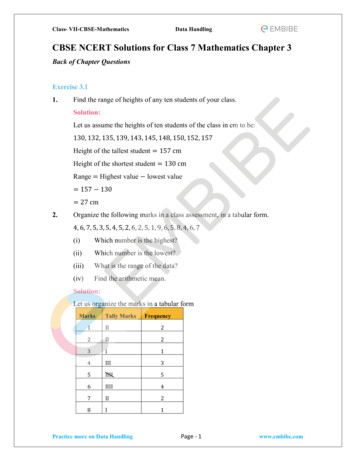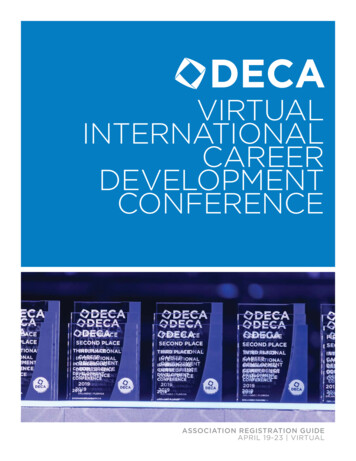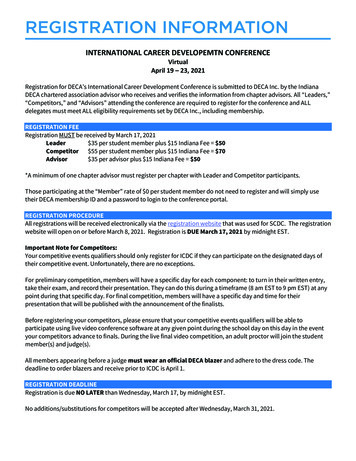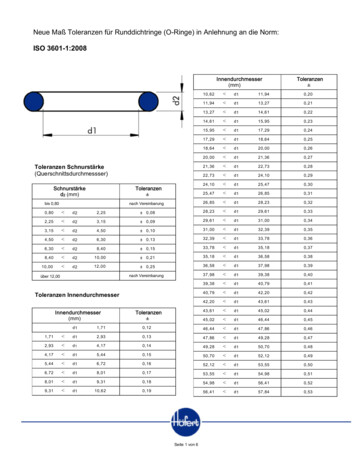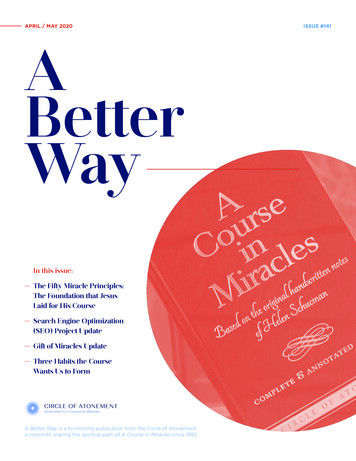
Transcription
APRIL / MAY 2020ABetterWayIn this issue:The Fifty Miracle Principles:The Foundation that JesusLaid for His CourseSearch Engine Optimization(SEO) Project UpdateGift of Miracles UpdateThree Habits the CourseWants Us to FormA Better Way is a bi-monthly publication from the Circle of Atonement,a nonprofit sharing the spiritual path of A Course in Miracles since 1993.ISSUE #141
A BETTER WAYContents2Founder’s Letter: Navigating a Time of Great Change3Editor’s Letter: A Season of Rebirth4The Fifty Miracle Principles: The Foundation that Jesus Laid for His Course5Search Engine Optimization (SEO) Project Update15Gift of Miracles Update17Course Companions News18Three Habits the Course Wants Us to Form19Q&A23Help Us Share A Course in Miracles with the World25Bookstore Items26Events Calendar27
A BETTER WAYFounder’s Letter:Navigating a Time ofGreat ChangeAs human beings, our constant aim in life is to makeeverything go right on the outside, to arrange the chessboard exactly as we want it. When we succeed, webelieve our ego’s empty stomach has temporarily beenfilled. When we don’t, we nurse grievances.Yet surely life has taught us that this is a fool’s errand. Thevery circumstances we try so hard to tame are beyond ourcontrol. This fact is being powerfully brought home to allof us now, as we face the coronavirus pandemic. It’s as ifa tsunami is washing through our communities, and whilewe hoped that we were far enough from the shore that itwouldn’t reach us, we can see the water now coming upour own streets.In the face of it, our minds need to do what they alwaysshould do, even in times when we are hanging onto theillusion of control: They need to divide into two differentparts. One part of us needs to attend to dealing with thetsunami, which means responding in whatever ways theexperts and our personal guidance deem responsible,prudent, and helpful. And the other part of us needsto rest in a peace that can never be shaken, because ittowers so high above this world that no waves could evercome close to it. The Course says, “There is an ancientpeace you carry in your heart and have not lost” (W164.4:2). We can settle into that place and take refugethere.These two parts, however, need not be separate fromeach other. The famous Text section “I Need Do Nothing”(T-22.VII) paints a picture in which they are integrated. Inthis picture, our minds are constantly resting in the eye ofthe hurricane (to switch the metaphor), the quiet center3in which all is at peace, in which we do nothing. This quietcenter then becomes the very source of our actions outthere in the storm. From this center, we will be sent onbusy doings in which we “use the body sinlessly” (T-22.VII.10:7) to uplift those who are caught in the storm. Andwhile we are doing that, this same quiet center will giveus “rest in the midst of every busy doing on which [we]are sent” (T-22.VII.10:6). Thus, the quiet center will guideus and it will rest us, even while we don our raincoats andmove about in the storm’s “raging activity” (T-22.VII.10:5).We don’t have to be inwardly shaken by the tsunami.Things don’t have to go exactly as we want on theoutside. We don’t have to be in control of everything. Wecan remain rooted in a peace beyond this world, and thatpeace can guide us and rest us, as we face the currentstorm.With love,Robert PerryFounderCircle of AtonementP.S. I have also written a piece that applies guidanceHelen Schucman received about whether Bill should geta flu shot to the issue of the coronavirus. The benefit ofthis guidance is that we get to see what the author of theCourse would say about a somewhat similar situation. Ifyou are interested in reading that piece, or watching ourrecent Sunday Gathering on coronavirus response, youcan find both at circleofa.org/coronavirus.
A BETTER WAYEditor’s Letter:A Season of RebirthWelcome to our new and improved A Better Way. Thefirst issue of A Better Way was published in October of1991 as a hardcopy newsletter. It was discontinued afterthe 140th edition in April/May of 2017. During this seasonof resurrection, we felt it would be the perfect time forA Better Way’s rebirth as a digital publication. We areexcited to offer issue #141 to our readers and hope it willenhance your study and practice of A Course in Miracles.Each issue will have a featured article and a fewadditional articles. It will contain organizational updates,upcoming events, Course Companions news, podcasthighlights, bookstore products, and an events calendar.We will also include a mailbox where we invite readercomments, and a Q&A section.The featured article in this issue is “The Fifty MiraclePrinciples” by Robert Perry. Have you found theseprinciples difficult to understand or lacking in clarity, yetknow somehow they are very important? I feel certainyou will find this article enlightening and helpful indeepening your understanding. It is especially effectivewhen used as an aid while studying the principles. Theseprinciples are, after all, the very foundation of the Course.When I agreed to assist in this project, I wasn’t quiteprepared for the technological learning curve. Not being a“techie”, I am particularly appreciative of Danielle Scruton,Community Manager for the Circle, for her instructionand patience. We appreciate your patience as well as welaunch and continue to refine and improve each issue.4The Easter season brings renewed life and growth, andnew beginnings. As we journey through this sacredseason, may we all experience the Christ reborn in us.There is such a sense of hope and promise. And Jesus’promise is that we will all go home. We go together, youand I.With love and blessings,Janet ChandlerProject ManagerCircle Certified Teacher
A BETTER WAYThe Fifty MiraclePrinciples: TheFoundation that JesusLaid for His Courseby Robert Perry5ou pick up this strangebook called A Coursein Miracles. How, youwonder, can a bookteach you to performmiracles? Then you open the coverand find, to your relief, that the veryfirst section contains fifty miracleprinciples. Surely these principles willclarify something about the miraclesthis book is going to teach you.These principles are obviously meantto lay a foundation that will set youup for whatever this “course” is.YBut as you dive into reading theprinciples, you discover that theyare frustratingly cryptic. Each onewhizzes by without elaboration, tobe followed by the next puzzlingprinciple and the next. You thusreach the end of this section slightlydisoriented and with little or noclarity about what these miraclesare. And so you resign yourself tohoping that perhaps other, moreexperienced students can clue you in.
A BETTER WAYTHE FIFTY MIRACLE PRINCIPLES: THE FOUNDATION THAT JESUS LAID FOR HIS COURSEThis is the situation that mostof us have been in. We sensethe fifty miracle principles areimportant, even foundational, butwe end up distancing ourselvesfrom the section. It just seems tooimpenetrable. And in this vacuum, wehave relied on what everyone aroundus has said, that miracles are “shiftsin perception.”As many of us now know, however,the situation was different inthe original dictation that HelenSchucman received. The miracleprinciples were not all squeezed intoone 1300-word section. They werescattered over approximately 20,000words of teaching. This extra materialcontained both elaboration on theprinciples and real-life examplesof the principles. Thus, in theiroriginal context, they were the veryfoundation they were meant to be.We need this foundation. It’s as ifthe author, at the beginning of hiscourse, grabbed us by the shouldersand pointed us in the right direction.“There,” he said. “That’s where you’reheading.” In the absence of this cleardirection, we have been wanderingall over the place.Recently, I did a study of the miracleprinciples as they appear in theCompleted and Annotated Edition,which presents them within as muchof their original context as possible.Forty-eight of the fiftyprinciples came together on asingle clear idea: that miraclesare “expressions of love.”6What did I find? I found that fortyeight of the fifty principles cametogether on a single clear idea: thatmiracles are “expressions of love,”a term Jesus used seven times todescribe miracles. They, in otherwords, are interpersonal acts oflove. The idea that they are about aninternal shift in perception is present,but in only two of the principles (37and 50). And even there, the conceptis slightly different from the usualidea. Rather than miracles beingshifts in perception, they are internalcatalysts from Jesus that bring aboutshifts in perceptions.In honor of the foundationalimportance of the fifty miracleprinciples, I have tried to clarify andsummarize all of them here. I firstrewrote each principle in such a wayas to, as best I could, make clearits real intent based on its originalcontext. (Note that if I include aquote from the principle itself, Idon’t provide a reference—since itis obvious where it’s from—but if Iquote from outside of the principle, Ido give the reference.)Then I arranged the principlesinto fifteen categories and wrotea summary of each category. Thismeans that the principles arepresented not according to theirnumerical order, but according towhich category they fit best in. Ithen introduced the entire collectionwith an overall definition of themiracle based on all the categories.Please note that this is a definitionof the main meaning of miracles as“expressions of love.” If you want adefinition of the more familiar kind ofmiracle, you can flip to the end andsee my summary under “the internalmiracle.”The miracle principles I’vesummarized here are from theComplete and Annotated Edition.They differ slightly from the fiftyprinciples in the Foundation forInner Peace Edition. They alsodiffer slightly from the forty-three
A BETTER WAYTHE FIFTY MIRACLE PRINCIPLES: THE FOUNDATION THAT JESUS LAID FOR HIS COURSEprinciples in the Urtext and thefifty-three principles in the “OriginalEdition” published by the Coursein Miracles Society. In selectingwhich statements to regard asmiracle principles, we followedthe convention one can see onHelen’s notebook pages, in which amiracle principle was a statementdirectly about miracles that was thebeginning of a paragraph, usuallywith a blank line preceding it. Usingthis method, we arrived at an evenfifty principles.As you read the summaries thatfollow, I ask you to open your mind tothe idea that the content expressedhere (allowing for any shortcomingsin my interpretation) is something likethe foundation that Jesus was tryingto give his students with his miracleprinciples. These principles werehis attempt to explain his curioustitle—A Course in Miracles—and toproperly set students up for thecourse that would follow. They werehis attempt to say, “Here, this is whatI am going to teach you.”At the end, I encourage you to askyourself the following question: “Howdoes this affect my perception of ACourse in Miracles?”These principles were Jesus’attempt to explain his curioustitle – A Course in Miracles –and to properly set studentsup for the course that wouldfollow.7Overall definitionMiracles are expressions of love—oneperson expressing love to another.To give miracles, then, you musthave love in you. You must have aperception of those on the receivingend as having inestimable worth andas being your equal. Your miraclehonors the holiness and perfectionthat God created in them. This willheal them, restoring their sense ofwholeness and even healing theirbody. And you, as the giver, willgain in love and strength as well.Your miracles will heal individuals indistant places, allow groups you arepart of to smoothly cooperate, andultimately bring closer the day wheneveryone will reunite in Heaven. Youshould devote every day to givingmiracles, for that is what time is for.Miracles as expressions oflove and forgivenessMiracles are “expressions of love,”in which one person communicateslove to another. It is the love andforgiveness within the miracle thatis the real healing agent. This loveand forgiveness, once accepted intoyourself, naturally wants to extendoutward and shine away the darknessin others.3. Miracles are “expressions oflove”—one person expressing loveto another. “The real miracle is thelove that inspires them.” This meansthat all expressions of love—eveneveryday ones—are miracles.22. When you accept God’sforgiveness into yourself, its light inyou looks out and cannot toleratethe idea that others remain in anunforgiven state. So the forgivenessin you naturally expresses itself in theform of giving forgiveness to themand thus shining away the darknessin them. Through this, you reaffirmyour own initial acceptance of God’sforgiveness.
A BETTER WAYTHE FIFTY MIRACLE PRINCIPLES: THE FOUNDATION THAT JESUS LAID FOR HIS COURSEThe inner content vs. theouter formWhat matters is not the behaviorthat expresses the love, or even thespectacular outer result that willsometimes take place. Miracles arenot about performing feats of emptymagic or dazzling onlookers intosuddenly believing. They are aboutthe love that passes from one personto another.2. The outer expression is ultimatelyunimportant. It is just the wrappingfor the gift. What matters is the lovethat is being expressed, “and this is farbeyond human evaluation” (T-1.3.2:4).10. A miracle is not about producinga flashy spectacle to make skepticalpeople suddenly believe. It is reallyabout the love that passes from onebeliever in the power of God’s love toanother believer.14. Miracles arise from a genuineconviction in the truth of love, whichis why they inspire conviction inothers. Without that conviction,the miracle worker is essentiallyperforming a feat of magic, notbecause he really believes inanything; he merely believes inhis own magical powers. This is apointless use of the mind.A gift from those who arecurrently more in touch withloveA miracle worker has opened up inhimself a deep well of love, the verything the miracle receiver currentlylacks. The miracle is a gift, then, thatlets the receiver share in the innerabundance of the giver. This, forexample, is precisely what parentingshould be. It should be miracleworking.7. A miracle heals the receiver. Itsupplies him with the love he lacks,being given by one who is currentlymore in touch with that love.40. Parenting should be miracleworking: an endless series ofexpressions of love. This is howparents can give of their greaterabundance and help their child sharethat abundance. When they do not dothat, their child’s perception becomesdistorted, and this causes a tear in thefabric of the entire family of God.Miracles as a naturalexpression of the love in youThe love that is the truth in younaturally wants to express throughyou. Your job is to let it do this sohabitually and effortlessly that itbecomes involuntary. To force the loveto flow only to your favorite recipientsgoes against the very nature of love.4. Expressing love needs to becomean involuntary habit. There is auniversal love in you that you mustallow to express freely. If you decidewhere to direct that love, you willnaturally funnel it toward your favoriterecipients. This so goes againstthe very nature of love that it “maydestroy” your miracle-working talent.5. “Miracles are natural” becauseuniversal love is your nature.Expressing love, therefore, is the mostnatural thing in this unnatural world.Not doing it means you have losttouch with who you are.8
A BETTER WAYTHE FIFTY MIRACLE PRINCIPLES: THE FOUNDATION THAT JESUS LAID FOR HIS COURSEThe right-mindedness thatleads to miracle givingYou have a right to perform miracles,but first you must allow yourthoughts to be purified. You mustaccept love from your Creator, soyou can give it to others. You mustbecome aware of the Christ withinand open the spiritual eye in you,which sees the truth in others andsees that their errors are unreal.6. You have a right to performmiracles. Everyone does. But first,you need to purify your thoughts,for miracles are the expression ofpurified thought (otherwise knownas love).11. Prayer is what makes miraclespossible. In prayer, you enter intocommunion with your Creator andreceive His love. And this suppliesthe love that you express throughmiracles.38. “The spiritual eye is themechanism of miracles”—the agencythat produces them. This is becausethe content of miracles is true seeing,which is exactly what the spiritualeye does. The spiritual eye is a facultyin you that sees the truth regardlessof appearances.39. The spiritual eye generatesmiracles because it correctly seesthat the error in the receiver is false,or unreal. This dispels that errorin the same way that light dispelsdarkness.At the heart of the miracleis a loving perception of thereceiver.945. The miracle is the outerexpression of a deeply spiritual innerawareness—an “awareness of Christand acceptance of His Atonement.”This places us in a state of grace,through which we then becomeeffortlessly gracious, so that wewelcome in the stranger and considerhim to be our dear brother.The perceptual content ofthe miracleAt the heart of the miracle is a lovingperception of the receiver. Thisperception overlooks the receiver’sbody completely, seeing only hiswholeness and his inestimablevalue, along with your own. It seesthe universal mark of God in him,recognizing him as your long-lostbrother. This perception is what healshim.17. When you give a miracle, fora moment you forget the otherperson’s body. Your perception shiftsaway from the body into the realmof the invisible. That is why a miracleheals, because it was the recipient’sidentification with the body thatmade him sick.18. A miracle “is the maximal serviceone person can render another.”The inner content of the miracle isyour recognition of your neighbor’sinestimable value and your own. Amiracle “is thus a way of loving yourneighbor as yourself.”41. At the heart of the miracle is aperception that the receiver bearsthe universal mark of God and is thusyour long-lost brother in the family ofGod, as is everyone.42. “The perceptual content” ofany miracle you give is a vision ofthe wholeness of the receiver. Thereceiver may see himself as deeplylacking inside, but your perception ofhis inner abundance heals his “faultyperception of lack.”
A BETTER WAYTHE FIFTY MIRACLE PRINCIPLES: THE FOUNDATION THAT JESUS LAID FOR HIS COURSEHonoring the holiness andperfection in the receiverThe healing effect on thereceiverBecause of the loving perception atits heart, the miracle involves a deephonoring of the receiver. It honorsthe holiness and perfection thatGod created in him. It thus implicitlypraises the Creator of that perfectionand, at the same time, releases thereceiver from his “nightmares abouthimself” (T-1.33.2:2).Because the miracle worker forgivesthe receiver, seeing only the spirit inhim, it awakens this same awarenessin the receiver. It raises him into thesphere of celestial order, in which heis already perfect. There, he comesface to face with his true holiness. Heis released “from his misplaced senseof isolation, deprivation, and lack” (T1.43.1:1). His body is healed. His pastis wiped away. And he steps forwardinto a new future, in which he nowbecomes a miracle worker himself.30. By giving miracles, you areimplicitly praising God. You areaffirming the divine perfection Hecreated in the miracle receiver. Inother words, you are praising theCreator by acclaiming His handiwork.31. Miracles, even at their mostremarkable, “should inspire gratitude,not awe.” The miracle worker issimply honoring the holiness thatGod placed in the miracle receiver.The receiver should be grateful tohim, but God is the One to Whomthis gratitude is ultimately due.33. The miracle receiver has allowedhis mind to be possessed by “evilthoughts” (T-1.33.3:3) and, as a result,he is plagued with “nightmaresabout himself” (T-1.33.2:2). Themiracle worker sees past all this tosomething genuinely lovable in him.The miracle he gives is an act oftruly honoring the receiver, and thisfrees him from his inner demons andrestores him to his right mind.A miracle reawakens in thereceiver the awareness that hisreal identity lies in his spirit,not his body.1013. A miracle leads to rebirth. Itwipes away the past and thus putsthe receiver back in touch with hisoriginal birth—his creation by God.Being thus reborn, he steps forwardinto a new future, one that has beenreleased from endless repetition ofthe past.21. A miracle reawakens in thereceiver the awareness that his realidentity lies in his spirit, not his body.This awareness is what heals him.26. The miracle receiver hasconfused the levels. He has takenthe reality, identity, and happinessthat belong to the spiritual leveland assigned those qualities to thephysical level. That is why he is sick.By seeing him as spirit, not body,the miracle worker rearranges thingsin the receiver’s mind, placing “thelevels in their true perspective.” Andthis healing of the receiver’s basicperspective on life heals all forms ofsickness in him.32. The miracle receiver is split offfrom his own holiness. That holinesswants to be known to him, needs tobe known to him, but cannot of itselfmake that happen. Christ, therefore,must intercede on its behalf. Heinspires the miracle worker to givethis person a miracle, and this putsthe receiver back in touch with hisinherent holiness. It thereby raises“him into the sphere of celestialorder,” in which he is already perfect.
A BETTER WAYTHE FIFTY MIRACLE PRINCIPLES: THE FOUNDATION THAT JESUS LAID FOR HIS COURSE34. The miracle forgives the receiver,restoring him to the fullness of spiritand filling him with strength. Henow feels perfectly protected, forthere are no gaps or cracks in hiswholeness where threat could enterin. And having been released, he nowjoins the plan to release all others.43. Miracles affirm that the receiver’strue condition is a state of Sonship,which implies that he is complete andwhole, an indispensable member ofthe family of God. This affirmationcarries so much power that it releaseshim “from his misplaced sense ofisolation, deprivation, and lack.”Miracles as a power notof this world, which canoverturn the laws of thisworldMiracles carry the power of love, andlove is not of this world. Its poweris always maximal. Therefore, it canheal any problem, any sickness, andany misperception with equal ease.It can reverse the taxing laws of thisworld and thus can heal the sick andeven raise the dead. It can heal thesethings because our thought madethem, and our thought can abolishthem.1. “There is no order of difficultyamong” miracles, which means thatthey can heal all problems with equalease. Why? Because love is the powerwithin miracles, and love is always atfull power. Every expression of it ismaximal.12. Miracles are the expression ofthought (the thought of love), andthought is so powerful that it makesthe physical realm and creates thespiritual realm.20. Miracles do not rest on the laws oftime. They are a case in which the lawsof a different order—eternity—come inand overturn the depleting laws of thisworld.23. It seems as if “time and tide waitfor no man” and that “In this worldnothing can be said to be certain,except death and taxes” (Jesus pointsout that “tax” also means “strain”). Yetmiracles can overturn even the mostseemingly immovable conditions inthis world, because we made thoseconditions ourselves and can thereforeabolish them.49. Since the miracle possesses apower not of this world, it is able toheal misperceptions in the receiverno matter what kind they are or howextreme they are. Miracles are selective,in a sense, in that you are guided togive them to those who will accept anduse them. But in regard to the size ofthe problems they are directed toward,they are completely indiscriminate.Gain for the giver as wellDo not think that when you give amiracle, you have lost or sacrificed.A miracle defies physical laws in thesense that you, the giver, gain as well.You and the receiver experience ashared recognition of equality andmutual worth. This shortens yourjourney (along with the receiver’sjourney). It brings more love to you. Itincreases your reservoir of strength.And it allows you to perceive clearly,seeing “the truth as God created it”(T-1.36.2:2).11
A BETTER WAYTHE FIFTY MIRACLE PRINCIPLES: THE FOUNDATION THAT JESUS LAID FOR HIS COURSE8. Miracles are an exchange, in thesense that the giver doesn’t justgive something away, but receivessomething in return. This reversesphysical laws, for according to them,when you give something away, youhave lost it.9. A miracle reverses the physicalorder because it is not just therecipient who gains; the giver gainsas well. Both of them come awaywith more love.16. Miracles supply the lack ofstrength in the receiver and, at thesame time, increase the reserve ofstrength in the giver. They thus prove“that it is as blessed to give as toreceive.” They are powerful devicesfor teaching this key truth.36. Given that miracles containright thinking, they also promoteright thinking and clear sight in thegiver. Expressing love enables youto accurately see the boundariesbetween yourself and others andthe boundaries in your own mind.And it enables you to see past theboundaries, perceiving “the truth asGod created it” (T-1.36.2:2). It putseverything in true perspective foryou, showing you that bodies areinconsequential and that spirit is allthat really matters.47. A miracle “lessens the needfor time.” It sparks a moment inwhich the doer and receiver sharein the recognition of their mutualequality, holiness, and worth. It thus“introduces an interval from whichthe doer and the receiver bothemerge much farther along in timethan they would otherwise havebeen” (T-1.47.2:3).Miracles—expressions of love—arewhat make real cooperation possible.12The larger effects of miraclesMiracles have effects far beyond theimmediate interaction of giver andreceiver. They make cooperationpossible, and with it, collectiveaccomplishment. Each one releasesmultiple people, establishing “aninterlocking chain of forgiveness”(T-1.24.1:1). They heal people at adistance, both when the miracleseemed wasted on the receiverand when the miracle was neverexpressed in the first place. Theycollapse time and thus bring closerthe day when all minds will unite inChrist, and time will be over.19. Miracles—expressions of love—arewhat make real cooperation possible.And cooperation is what, in turn,makes collective accomplishmentpossible. Miracle-based collaborationwill ultimately culminate in theuniting of all minds in Christ.24. Each miracle releases multiplepeople, who will, in turn, release yetmore. And this release ripples intothe past and future as well. In thisway, miracles will eventually form“an interlocking chain of forgiveness”that will cover literally everyone. Thatchain, when fully completed, is theAtonement.44. “Miracles arise from a miraculousstate of mind.” This state is somiraculous that it can do miracleson its own, in the absence of anybehavioral expression. It can go outto literally anyone, no matter how faraway, “even without the awareness ofthe miracle worker himself.”46. Do not think that a miracle youdo that seems to have no effect islost. Quite the contrary, “It touchesmany people you may not evenknow, and sometimes producesundreamed-of changes in forces ofwhich you are not even aware.”
A BETTER WAYTHE FIFTY MIRACLE PRINCIPLES: THE FOUNDATION THAT JESUS LAID FOR HIS COURSE48. “The miracle is the only devicewhich you have at your immediatedisposal” for collapsing time. Themiracle worker therefore uses thisdevice gladly, knowing “that everycollapse of time brings everyonecloser to the ultimate release fromtime, in which the Son and the Fatherare one” (T-1.48.4:3).The miracle worker as a linkin a greater planYour role may seem ineffectual andyour expressions of love may appearinsignificant. But by doing them,you serve the spirit. You becomean essential link in a chain whosepurpose is the liberation of all God’screations.27. The miracle you give ultimatelycame to you from God throughJesus, on its way to passing throughyou. You, then, form an essential linkin a chain that is ultimately aimedat releasing everyone. Acting as thislink is a privilege and also a need, foryour soul “cannot rest until everyonehas found salvation.”35. Simply through givingexpressions of love, you serve thespirit and unite with Christ for theliberation of all God’s creations.Each day should be devotedto giving miracles. The wholereason time was made was sothat you could do somethingtruly productive with it.13Making your day aboutmiracle givingYou should devote each day to givingmiracles. This is how you can learnthe lessons that time was made tohelp you learn. To do this, though,you need to let Jesus guide youthrough the minutiae of your day sothat you can be there at the momentpeople need you.15. Each day should be devoted togiving miracles. The whole reasontime was made was so that youcould do something truly productivewith it. This is how you rememberyour real creativity, which lies inHeaven. All time is therefore “lessontime”—it is there so you can learn.It will cease when you no longerrequire it for learning.25. It is essential to not waste timeby getting through the minutiaeof the day in your way. Let Jesus’guidance speed you through it, sothat you are available when he callson you. “Miracles depend on timing,”because, as we all know, people needyou when they need you.
A BETTER WAYTHE FIFTY MIRACLE PRINCIPLES: THE FOUNDATION THAT JESUS LAID FOR HIS COURSERevelation and miraclesThe internal miracleRevelation is the direct experience ofGod. A miracle is an interpersonal actof love. Right now, the impulses forboth—revelation and miracles—try toenter your mind, but become blockedor distorted. Giving miracles healsthis condition, allowing your mind tobecome a harmoniously functioningwhole again. Miracles free yourmind from fear and thus open youto the state that transcends all fear:revelation.Miracles are n
book called A Course in Miracles. How, you wonder, can a book teach you to perform miracles? Then you open the cover and find, to your relief, that the very first section contains fifty miracle principles. Surely these principles will clarify something about the miracles this book is

